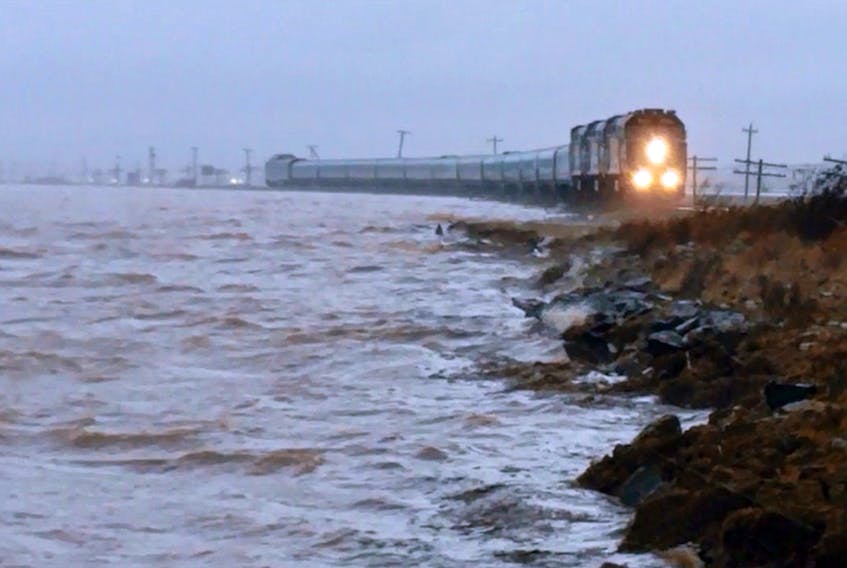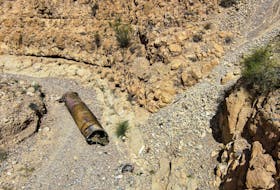SACKVILLE, N.B. – It’s not a matter of if it will happen – but when.
A major flood event in the region is imminent, as sea levels continue to rise and climate change brings with it more frequent and intense storms.
And with an aging and crumbling dike system that is inadequate to hold back the rising tides of the Bay of Fundy in the case of a severe storm, the fallout for the entire Tantramar marsh area could prove to be disastrous.
Critical infrastructure, such as the Trans-Canada Highway and the CN Rail line along the New Brunswick and Nova Scotia border, is at risk and, if flooded, would cut off a key transportation corridor for trade and commerce in Canada.
That’s why municipal officials in both border towns are calling on provincial and federal governments to step in and start taking action - and soon – to protect these investments.
“Now’s the time,” said Sackville Mayor John Higham. “We need coordinated action or something bad is going to happen.”
Higham, along with Amherst Mayor David Kogon and Cumberland County Warden Allison Gillis, sent out a letter last week to infrastructure ministers in Nova Scotia, New Brunswick and Ottawa, inviting them to a meeting to begin the planning process around repairing or rebuilding the dikes.
The letter requests that the ministers, and/or their senior representatives, join local officials within the next four to five weeks to fully discuss the issue, and move forward on creating a working group to outline any possible funding sources, draft an initial terms of reference, and put together a submission that summarizes the required funding and action needed to protect the infrastructure across the Tantramar marsh.
“We need to start planning for this and taking some action,” said Higham.
He said it’s important to bring all the groups together who have a responsibility in protecting these assets. He feels there needs to be a greater sense of urgency from the other levels of government on this issue, as the infrastructure is of significant national importance.
“It’s a Canadian resource, not just a Sackville one or an Amherst one,” he said.
Over the past few years, as study after study have revealed the significant impacts climate change will have on the local area, municipal officials have worked on collecting the data on the scope of the threat, have held emergency preparedness and adaptation workshops, and even developed a climate change adaptation plan.
Higham pointed out, however, that coming up with a solution to protect this infrastructure should involve more than just municipal governments.
“As a municipality, we have no authority or ability to address this problem on our own.”
It’s a complex issue, he said, one that requires national and interprovincial commitment and involvement of multiple public agencies as well as affected private ventures.
But no one has stepped forward to take the lead and there has been no coordinated approach to how it should happen, said Higham.
Protection of this infrastructure relies on a series of agricultural dykes first built in the 1700s by Acadian settlers. The aging dikes, combined with documented rising water levels and increased frequencies and intensity of weather events, led to new floodplain mapping being conducted a couple of years ago. This mapping clearly shows that a flood that will breach the national rail and road networks is no longer a theoretical question, it is a matter of how soon it will occur.
With that in mind, the two mayors and the warden met last month with Beausejour MP Dominic LeBlanc and Cumberland-Colchester MP Bill Casey, who both agreed talks at the national and the provincial level needed to get under way ASAP, which prompted the letter to senior infrastructure department officials.
Higham said he is hopeful that once the infrastructure ministers are fully aware of the significant risks, they will view the rebuilding of the dikes as a top priority. Federal funding is available for projects of national importance, he said, which he believes the work would qualify for because of the threat a flood would pose to the main road and rail links, as well as the power transmission lines.
“This infrastructure is a key part of a trade and commercial system of ports, marine terminals, airports, border crossings and road and rail connections,” the municipal leaders stated in their letter. “The extent of damage of a major flood event in this area will ripple across the country, have a huge impact on both provinces, and will be devastating to local governments at both ends of the Tantramar marsh.”
A 2016 study of this topic by Natural Resources Canada estimates that a flood that interrupts road and rail activity would cause more than $50 million per day in lost commerce.
That same report also examined adaptation options and determined that the most cost-effective measure was to re-engineer the dikes with a specific intent to protect priority infrastructure. This work to upgrade the dikes has been roughly estimated at $70 million.
Higham is hopeful the ministers will be agreeable to meeting within the next few weeks so that actions can be taken and work can possibly get under way this winter.









